|
"Ciao Enrico,
It is sad news, yesterday Elio Zagato passed away.
He made a major contribution to Maserati with the A6G by Zagato and the A6GCS by Zagato. He created classic works of art not
only for Maserati, but with many other legendary marques.
If possible, could you upload the attached official release onto your web site. I also attached original message from Zagato marketing dept.
Best regards,
Masato - Maserati Club Japan."
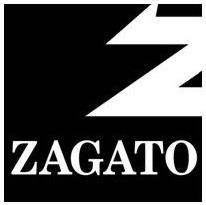 Milano, 15 Settembre 2009 Milano, 15 Settembre 2009
Si è spento ieri, all’età di 88 anni, il Dr. Elio Zagato.
Figlio di Ugo Zagato, fondatore del celeberrimo Atelier milanese - famoso in tutto il mondo dal 1919 per la realizzazione di carrozzerie sportive su misura - Elio è stato una figura di spicco nella storia del design automobilistico mondiale e delle corse Gran Turismo del dopoguerra.
Imprenditore, pilota e gentlemen driver, corse per la prima volta a Piacenza nel 1947, a bordo di una Fiat appena ricarrozzata, regalo di Laurea di suo padre.
Da quel momento non smise mai di sviluppare le sue amate Gran Turismo, lavorandovi durante il corso della settimana e testandole in pista nei week end.
Fu tra i fondatori della scuderia Milanese Sant Ambroeus. Incarnò per stile, eleganza e competitività la figura perfetta del gentleman driver Italiano nel periodo della dolce vita.
A partire dai primi anni ‘50 sviluppò le berlinette GT più famose a desiderate al mondo. Tra tutte ricordiamo la Fiat 8V Zagato, che diceva essere tra le sue preferite, l’Alfa Romeo 1900SSZ che spesso gli fu rivale in pista guidata da piloti concorrenti, le mitiche Ferrari 250GTZ, Maserati A6G, Aston Martin DB4GTZ e tantissime altre.
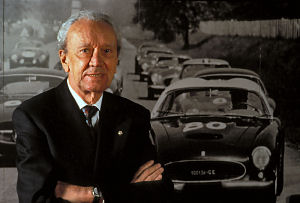 Condivise i tempi d’oro delle corse fatte in gilet ed elmetto con personaggi illustri quali Ascari, Fangio, Galluzzi, Nuvolari, Stagnoli ed altri. Enzo Ferrari lo chiamava “Zagatino”. Condivise i tempi d’oro delle corse fatte in gilet ed elmetto con personaggi illustri quali Ascari, Fangio, Galluzzi, Nuvolari, Stagnoli ed altri. Enzo Ferrari lo chiamava “Zagatino”.
Insieme all’amico Ercole Spada, sviluppò le leggendarie Alfa Romeo SZ, TZ e TZ2, seguite dalle eleganti Lancia Sport su telai Appia, Flavia, Flaminia e Fulvia.
Instancabile innovatore, insieme al padre Ugo inventò la mitica doppia gobba sul tetto, firma del marchio milanese, la coda tronca, i vetri in plexiglas e numerose soluzioni ancora attuali sulle vetture moderne.
Elio partecipò a 150 gare automobilistiche vincendone 82 e conquistando ben 5 titoli mondiali nella categoria GT. Vinse una Targa Florio, otto Coppa Intereuropa, tre primi posti di classe alla coppa d’oro delle Dolomiti, ed arrivò primo assoluto sul circuito dell’Avus di Berlino nel 1955.
Promotore del minimalismo milanese orientato alla funzione del design, Elio definiva le sue Zagato prima di tutto “originali”. A chi gli chiedesse di sintetizzare lo spirito delle sue carrozzerie, rispondeva: “La vedi quella? E’ diversa da tutte le altre? Allora è una Zagato”.
Andrea e Marella Zagato oggi, nell’anno del 90°Anniversario del marchio, mantengono integra l’emozione delle Carrozzerie d’Atelier che Elio imparò da Ugo e promosse durante la sua brillante carriera.
 Milan, the 15th of September 2009 Milan, the 15th of September 2009
Dr. Elio Zagato passed away yesterday at the age of 88.
Son of Ugo Zagato, founder of the famous Milanese Atelier, renowned in the whole world since 1919 for its custom made car bodies- Elio was a figure of great importance in the history of global automotive design and in the Gran Turismo race scene of the post-war era.
Entrepreneur, racer and gentleman driver, he competed for the first time in Piacenza in 1947, driving a Fiat which had just been re-bodied as a graduation gift from his father.
From that point onwards he never stopped developing his beloved Gran Turismos, working on them during the week and then testing them during the weekends.
He was amongst the founders of the Milanese Scuderia Sant Ambroeus. He embodied with perfection the style, elegance, and competitive spirit of the Italian gentleman driver of the ‘Dolce Vita’ era.
In the early 1950s he started developing the world’s most desired berlinette GTs. Amongst all of them we fondly remember the Fiat 8V Zagato, which he claimed to be his favourite, the Alfa Romeo 1900 SSZ which was often his rival in various races, the legendary Ferrari 250 GTZs, Maserati A6G, Aston Martin DB4 GTZ and many more.
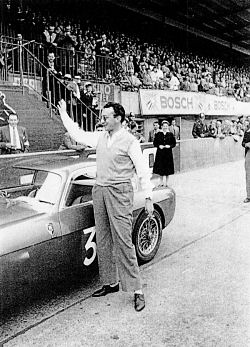 He took part in the golden age of competitions raced with vests and helmets with famous characters such as Ascari, Fangio, Galluzzi, Nuvolari, Stagnoli, and others. Enzo Ferrari called him “Zagatino.” He took part in the golden age of competitions raced with vests and helmets with famous characters such as Ascari, Fangio, Galluzzi, Nuvolari, Stagnoli, and others. Enzo Ferrari called him “Zagatino.”
Together with his friend Ercole Spada he developed the legendary Alfa Romeo SZ, TZ and TZ2s followed by the elegant Lancia Sports based on Appia, Flavia, Flaminia, and Fulvia chassis.
A constant innovator, together with his father Ugo he invented the celebrated double bubble, signature mark of the Milanese brand, the ‘Coda Tronca’, windows made out of plexiglas and countless other solutions still used on modern vehicles today.
Elio participated in 150 automotive races, winning 82 of them and becoming champion of the GT series a remarkable 5 times. He was victorious in the Targa Florio, eight Coppa Intereuropas, won three first places in the Golden Cup of the Dolomites, and came in first at the Avus circuit in Berlin in 1955.
Promoter of the Milanese concept of minimalism oriented towards functionalist design, Elio defined his Zagatos first and foremost as ‘original.’ Whoever asked him to synthesize the design spirit of his car bodies, he would reply to them “You see that car? Is it different from all the others? Then it’s a Zagato.”
Andrea and Marella Zagato, today, in the year of Zagato’s 90th anniversary, keep the spirit of the Atelier coachwork alive, a trade that Elio learned from Ugo and promoted throughout his brilliant career. |
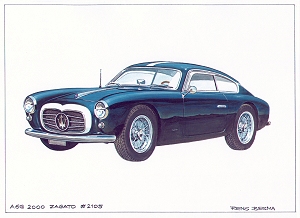
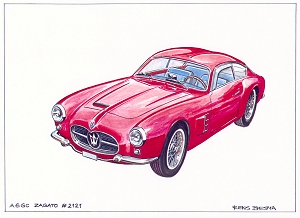
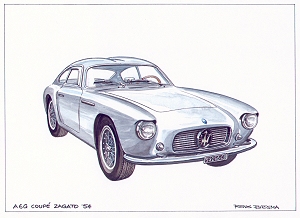
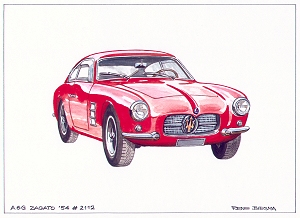
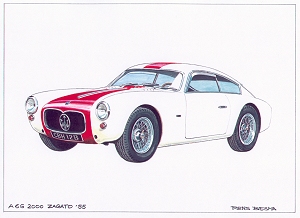
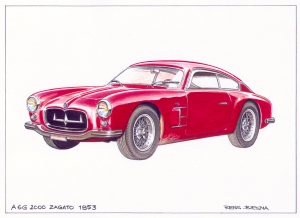
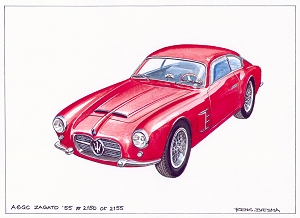
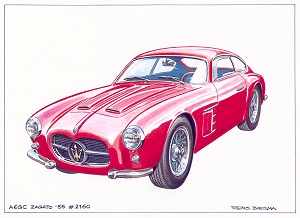
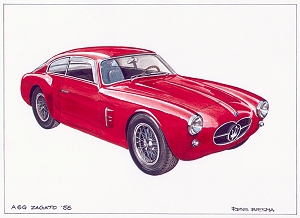
 Milano, 15 Settembre 2009
Milano, 15 Settembre 2009
